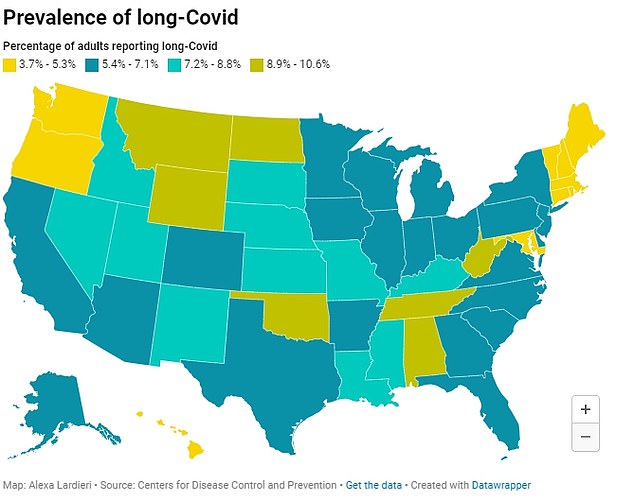Data shows that states where people were skeptical about the Covid threat have some of the highest rates of long Covid.
The Centers for Disease Control and Prevention today released a state-by-state breakdown of rates of this difficult-to-diagnose disease, based on self-reporting.
It revealed that in 2022 (the latest data available), seven percent of Americans reported having ever experienced long Covid, around 18 million.
The rates were highest, at 10.6 percent, in Republican-led West Virginia. The lowest rate range, from 3.7 percent to 5.3 percent, was seen in Washington, DC.
Montana, Wyoming, North Dakota, Oklahoma, Alabama, Tennessee and West Virginia were in the highest prevalence group: between 8.9 and 10.6 percent.
Regionally, prevalence tended to be highest in the South and Midwest and lowest in New England and the Pacific Northwest.
Hawaii, Oregon, Washington, Maryland, Connecticut, Rhode Island, Massachusetts, Vermont, New Hampshire and Maine had the second-lowest prevalence of residents reporting long-term Covid, between 3.7 and 5.3 percent .
The health agency analyzed data from the Behavioral Risk Factor Surveillance System, which includes information from more than 400,000 American adults.
The sampling of respondents was done through random telephone calls. Long Covid was defined as self-reporting any symptoms that lasted three or more months and were not present before becoming infected.
The CDC report did not provide an explanation for the rates, but states with higher long-term Covid prevalence also tended to have more Covid cases per 100,000 residents during the pandemic.
Additionally, states with more long-term Covid patients also tended to have lower vaccination rates, in addition to high rates of obesity and other chronic health conditions.
Countless polls have also shown that people in red states felt the danger of the Covid virus was exaggerated.
In Montana, only 12 percent of residents have received an updated Covid booster dose and the state’s case rate was 36,400 per 100,000 residents.
By comparison, Washington, D.C., has 32 percent of its residents up to date on booster doses and a case rate of 23,730.
Long Covid is estimated to affect between nine and 20 million Americans, but is notoriously difficult to diagnose as most symptoms resemble other health conditions and most diagnostic tests, such as a urinalysis or X-rays appear normal.
Doctors often dismiss patients because they think it’s all in their head or that they have a completely different condition.
The condition consists of a constellation of symptoms that persist after someone has recovered from their initial Covid infection, including relentless fatigue and mental confusion.
However, a study published in September 2023 found that the blood tests of people who claim to suffer from long Covid have distinct biological differences from those who do not suffer from the condition.
The study suggested that blood tests could be useful in identifying possible treatments for symptoms, giving hope to those who claim to be living with the condition.
The CDC report stated: ‘The findings in this report address an important data gap in knowledge about the prevalence of Long COVID.
“Given the increasing healthcare needs among people experiencing long COVID, continued assessment of prevalence data at the state and territory level could guide policy, planning or programming.”
“State-level estimates could also help identify geographic disparities in long COVID across the United States that could guide interventions to promote health equity.”

